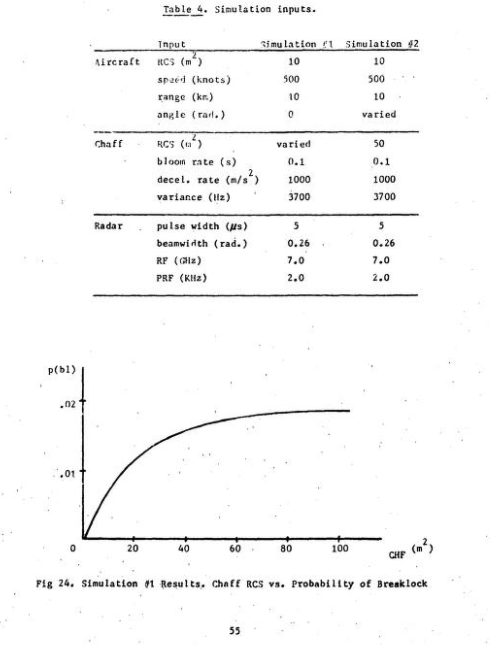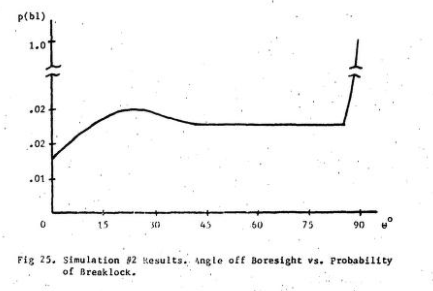-
Posts
1517 -
Joined
-
Last visited
Content Type
Profiles
Forums
Events
Everything posted by nighthawk2174
-
Right and search radars are a bit of a different ball game than the amraam's TR. I mean the pilots i've talked too have all said that the chance of decoying an amraam with chaff is laughably low. Plus SME's can be wrong too so its best to have a multitude of sources. Just outright disregarding all the sources i've posted, some even formerly classified, is not the way to go these people making these sources aren't idiots and should be listened too. RIght and the point i'm trying to make is the combination of bloom time, aircraft speed, and the rate that chaff slows down makes it so that in the time it has to make an effect (the res cell of the radar) its not going to be able to do much if really anything at all. More effect against lower res and less effect against higher res radars. We're talking much less than half a second for missiles like the amraam. The amraam being monopulse is even able to solve for multiple targets in the res cell with moderate accuracy with only two pulses.
-

Want F-117A Nighthawk - high fidelity module
nighthawk2174 replied to Cigar Bear's topic in DCS Core Wish List
RCS wise you could get a decent approximation with simulations but obviously the actual RCS profile is hella classified. But honestly with how simple DCS's RCS model is its irrelevant anyway until it gets modeled in the core game. From my understanding the biggest limitation documentation wise is related to some specifics of the weapon systems and i'd imagine the FLCS. For the rest however a -1 manual is out there I have a copy. -
Not really they are comparable they work of the exact same principles. Also It was not a specific radar but a generic con-scan FCR with MTI. That the radar was dragged onto the chaff and has lost lock of the aircraft. Language barrier? not sure what your trying to say here. Well I mean first off if the chaff is not in the resolution cell of the target then it's not going to really do anything. And it won't stay in the resolution cell for very long at all. Not to mention it takes time for the chaff to bloom which will negatively impact its effect while it's in the res cell. Plus with monopulse it has the ability to tell there are multiple targets in its resolution cell to the point it can compensate for this and track on the original target. Sure but is that effect even enough to make a difference? Based on what i've read I don't really think it has much noticeable impact especially with modern radars. No all of these features are there to reject clutter and keep the target locked. Hence why its an integrative (not sure if that's the correct word) proces, it aggregates a bunch of returns over a short time. And also how would this problem cause an immediate break lock? I don't think that doppler processing is at all overrated plus it doesn't work alone either there are other mechanisms that support each other. I completely disagree how it was before was far more representative imho based on all of the various papers that i've linked in this thread.
-
@BIGNEWY @GGTharos Couldn't find much more than this about chaff effectiveness but well its in the .01-.02% range for an older con-scan pulse tracking radar with MTI. Considering stuff like the amraam is going to have much better resolution, is monopulse, will be closer meaning an even smaller res cell, and is PD. And that based on other sources the bloom rate for the chaff in the simulation is highly optimistic well... An additional factor to also consider is that the RCS of the target aircraft is 10, which is reasonable but for the off axis test the rcs of the aircraft was not varied where it would irl where it'd grow significantly as you approached the beam. And even more so with an increase in look down or up angle on an aircraft.
-
The issue is their going for chaff when they should not be. The chaff is causing the missile to pull maximum g's away from the target towards bundles that are already significant distances behind the target and would already have dropped well below the Doppler gate. And if not the Doppler gate then the range gate (target in/near notch and missile opening gates as a countermeasure). Not even mentioning the techniques that monopulses can employ to counteract chaff as well. ED can easily give us a temporary solution by just returning the chaff resistance values back to what they were at when the new missile FM first dropped or just turning off chaff till its fixed. Its just stupid how good it is and its having a really bad negative effect on gameplay and I would not mind it going away until its fixed and work properly.
-

DCS - Nhawk's Weapons mod
nighthawk2174 replied to nighthawk2174's topic in Utility/Program Mods for DCS World
Yes if your the server aka the host and you have it your fine. If your using a dedicated server it has to have the mod as well as the people who connect. -
Yeah I mean that doesn't really shock me, from when I did some limited CFD I saw very little difference between current ER and CFD ER. Like there is some improvement but not a lot. Biggest difference was with the R/T for me, how are your results for these older missiles looking? Also, question is motor on/motor off drag differences modeled in the new AFM for missiles.
-
Yeah this isn't hard fix would probably take all of 3 minutes to fix and check.
-

AI aircraft magically know when you fire
nighthawk2174 replied to Father Cool's topic in Weapon Bugs
I think it should be dependent on a few factors when the AI gets to know if its been shot on: 1)Is the missile in the AI fov? Like with jester the AI should have a fov where it can see stuff, with a very high rate but small zone of detection. And a zone which rate drops off rapidly in exchange for a large zone. Blocked by clouds and cockpit as well ofc. 2)Day/Night? At night you would be able to see the motor from quite some range even farther off the axis of highest resolution, especially with NVG's. But controls will essentially be invisible (except with NVG to a still somewhat limited extent). While the reverse is true during the day. 3)Is the missile smokey? If not then even if it is in the fov it won't trigger the evasion algo. Should be a factor of smokeness and launch range that plays into this as well. An A model phoenix even though smokey when launched at extreme range is not going to be seen. 4)Is the missile detected by sensors? RWR? TGP? Radar? MAWS? All are sensors that can trigger the evasion algo. This imo is the minimum that ED needs to have for good AI. And I don't think it'd be too hard to code either, maybe a bit of a hit on performance in huge AI missions but i have no doubt its possible to do. -
Хорошо, здесь есть эффект, который DCS случайно получает правильно (вроде того), но ваш мозг имеет запас кислорода примерно на 5 секунд, и в течение этого времени (за исключением исключительно опасной G-нагрузки, высокоскоростных аварий) вы не потеряете сознание во время этого 5 - секундного резерва + -немного основанного на нескольких факторах, таких как то, как долго вы выполняли маневры с высоким g и количество отрицательных g, вытянутых в последнее время. Есть две истории rlf F15, которые следует рассмотреть вместе с этим, одна из них-во время войны в Персидском заливе пилот eagle слился с миг-25 и вытянул 12g примерно на 5-7 секунд в маневре split-s. Есть также случай с орлом, когда пилот практиковал acm над океаном и потерял осознание своего отношения. Он почти ударился о палубу и во время восстановления вытянул 13-13, 5 g примерно за 5-7 секунд. Теперь не поймите меня неправильно, g-модель DCS-это мусор по сравнению с IL-2, но она не обязательно ошибочна здесь, просто не полностью точна. Что такое определение Rmax для российских диапазонных графиков? Если это российские оценки AIM-120, о которых вы говорите, то это будет не первая российская оценка, которая будет ошибочной. Я бы брал результаты CFD по этим документам каждый день недели. Они предоставляют гораздо больше деталей, которые можно использовать для моделирования ракеты. Из моей собственной работы CFD работа ЭДА довольно хороша, хотя у меня есть опасения по поводу очень высокого сверхзвукового сопротивления (до высокого по сравнению с тем, что я получил), это все еще разумно. Я имею в виду, что ЭД точно не известен своими быстрыми результатами, но если ваше предположение здесь верно, давайте искать решения. Может быть, "3-я" партия сделает CFD (я уверен, что в сообществе есть люди с доступом и временем для выполнения этой работы) для российских ракет, и ЭД просто интегрирует эту работу. Если я правильно помню, они заявляли в прошлом, что нет никаких ограничений на то, что могут делать 3-е стороны, пока они могут показать, что это соответствует стандартам ЭДА. Кроме того, CFD требует времени и денег, вероятно, просто не хочет идти на полную катушку для каждой ракеты. Не совсем 2 года, но я понимаю разочарование темпами разработки новой модели ракеты. Хотя, когда серия 27R/T будет исправлена, я бы умерил ваши ожидания. Я сделал свой собственный CFD для многих ракет, я всегда был в пределах нескольких % от значений ED (120 high supersonic-единственное исключение), и в то время как 27R/T получит приличный импульс, основанный на том, что я сделал, ER/ET не получит массивного ускорения. Та же история была и с R77, сумма перетаскивания в игре сейчас почти точно такая же, как и у меня. На самом деле ему нужно только отрегулировать его высоту и маневренность, но даже тогда позвольте мне поделиться файлом tacview BMS, где я дал 120B и R77 точно такую же тягу и сопротивление, как и в DCS. 120B по-прежнему будет превосходить ракеты. Более дальнобойный, чем 77-й и АРХ против САРЫ против ЭР. 77v120.zip.acmi
-
No the maneuvering of the bandit is irrelevant to the filtering out of the flares as it can still filter flares out based on shape/intensity/location/los rate/ir spectrum/ and a whole slew of other factors. The signature of a flare is in not comparable to that of an aircraft and can always be filtered out because of this on fpa seekers.
-
A few notes A) the theoretical seeker they used for the testing their pattern recognition AI was limited in comparison to what you'd see on a 9x. For example it couldn't filter out flares based on the ir spectra, which makes sense considering its purpose is to filter just based off of shape B)The theoretical seeker was only given one frame to filter based on unlike irl on the 9x where it compares what it currently sees to previous frames if you had read further they would have noted that this ability to compare to previous frames has significant flare filtering power: C) The value of this paper is not in its ECCM (there is another study that focuses purely on this without any limitations) but rather it gives us a pretty well layed out explanation of how FPA seekers work and what they "see". The pattern recognition you see the results of in the image above is the writers first prototype of a neural network to help improve pattern recognition of the seeker. It lacks though the other tools to improve upon just the raw size and shape discrimination. Even then with all these limitations both it and other seekers have a 90-95% filtering success rate.
-
A few questions: A) For proximity fuzes: Could it be possible to define essentially a "bubble" for every aircraft representing its approximate dimensions and then that value is subtracted out of the distance from the missile to the target? That way you don't get missile missing because they didn't pass within 10ft of the pilots head? B) is it possible to make the target's computer a primary simulator of what is happening? Thus, if the missile is aimed at a target in the MP, that person's computer will process the simulation of what is happening as if it were in the SP updating the server with its calculations. I think the most important thing is that the target has an accurate idea of what is going on. If it turns out for the launch plane that the missile is a little laggy, in my eyes is an insignificant issue compared to the target having an accurate idea of what is happening. C) Is this just a percentage chance or will the targets position actually be continuously updated? And lets say the missile is notched then re-acquires it doesn't stop receiving updates then does it? As it should continue to receive them so long as the radar sees the target. Would be nice also to incorporate lag into this, essentially if the radar passes over the target and sees it then the missile gets an update. Not just continuously would make tws a bit less reliable at getting the missile through a notch and STT a lot better at this. Although tbf for the amraam if its getting datalink updates couldn't it just throw open its vgate and re-acquire with the range gate? Especially if in lookup or at a significant distance from terrain? D) Will the amraam get MPRF and HPRF modes simulated? As far as i'm aware, partially based on what i've seen in mace, they should have different sized notches, detection ranges, and fov's.
-
Yes but the blobs shapes and ir spectra will be different than that of the target and can be filtered purly off of that not even mentioning the fact that they have separated greatly from the target and could be filtered that way. I just don't see what you see i'm going to go with what has been stated by multiple pilots that flares were not deployed against the 9x. ? Even at longer ranges it would still be easy to reject flares. The missile could check: is the new target the same size as the the old? The same shape? The same emission spectra? Is the new target moving at the same rate as the one I was just tracking? Has the intensity of the target changed radically? (above images in your post take note of how much brighter the flares are). All of these could cause a flare rejection. There is a pretty detailed study about this out there as well, ontop of what GG, posted and it was shown that the seeker had an exceptional ability to filter out this new target the moment it could separate the two. Which even at far range would happen quite quickly considering the rate a flare would separate from an aircraft. You don't need much distance especially as you get closer to the target.
-
its 8km not more than 9... You can do the math to show this is not true balls in your court here. Hey there are documents out there about how this stuff works you can find it if you look. Looks to me like another angle of the target getting hit there were multiple aircraft in the area. Hec you can tell its a different pod, but still looking at the same area from a higher alt and different angle, as the symbology is set up differently and you can see the big ditch/road in both but from different angles.
-
That's only for a few degrees of fov you can do the math yourself. No not really its based on how the seeker works I don't know what you see in the video as I don't see any flares deployed at all you can go listen to the interview with the pilot who shot the 9x the way he puts it is he pulled the trigger the missile just flew off into to space not even guiding. I'd take his word over something that I don't see in the video. +1
-
More like 10+km, and for the IRST (and probably 9x) even more so considering it has 4x the resolution of the theoretical sensor used in the graph I posted, even then filtering by size is not the only mechanism though there is still the flares IR spectrum which can be used to filter it out. Plus the other possible filtering mechanisms I mentioned as well. The 9x over syria was not decoyed by flares there are multiple pilots who have said as much.
-
What Tharos said just the basic way the FPA seeker works basically makes them essentially immune (except in very specific circumstances, wrong target before launch or complete loss of los). They can reject flares based on their size and energy distribution/spectrum. Pyrotechnic flares, the ones we have now, are pinpricks of intense IR energy compared to an aircraft. And as such can be filtered out just based on that fact. I'm sure you could also filter by position, los rate, or energy rise time to supplement the filtering done by shape/energy.
-

Possibility that the RCS of R-77 is abnormally large.
nighthawk2174 replied to Admiral_ZIPANGU's topic in Weapon Bugs
The issue here may be less the RCS of the adder, which in all probability would be abnormally high for a missile due to the gridfins, but how active missiles work in DCS. I very much doubt they should be grabbing locks here on each other. Not only is it likely that in the above cases the other missile was outside each others FOV but why would it grab onto a target nowhere near the predicted intercept point? Especially for the amraam; not only does it not make much sense for it to grab onto a target nowhere near the predicted intercept point. But while it is getting datalink updates it should, according to real pilots, dump all other targets and guide on what the radar is locking even if the target is in the notch and even if there are multiple targets close to each other. -
I don't have a track but me and a friend were flying a couple of liberation missions and had the exact same thing happen. Occurs the moment you hit the Su25, makes me wonder if its related to jester callouts about splashing a target?
-

reported AN/APG-63 range is under-represented
nighthawk2174 replied to GGTharos's topic in Flaming Cliffs Bugs & Problems
This is for the original APG-63 correct and not post MSIP? Didn't MSIP retrofit eagles with an improved -63 that increased the radars detection range somewhat or am I remembering this wrong? -
All of them do only the FC3 stuff doesn't





